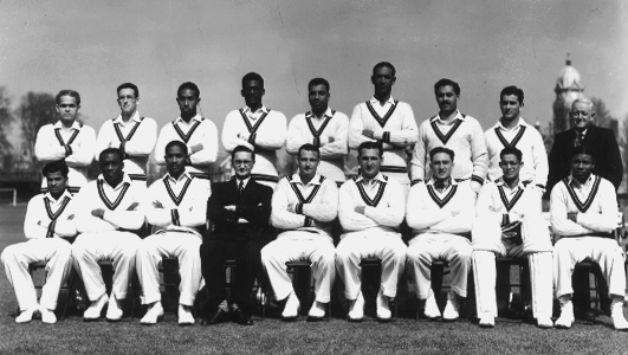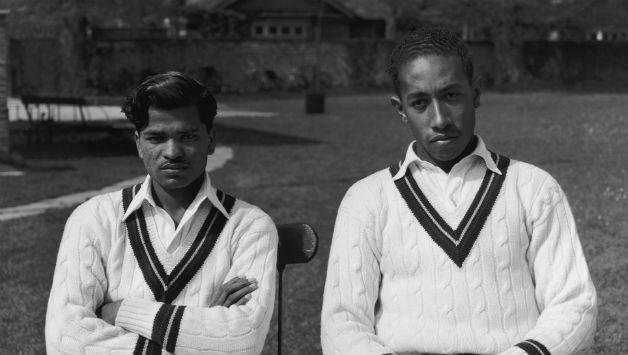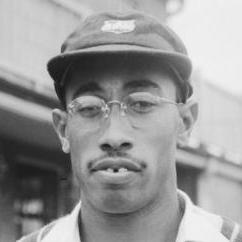
Alf Valentine, the first West Indian to take a hundred Test wickets, was born on April 28, 1930. Abhishek Mukherjee looks back at one half of the spin duo that had once taken the cricket world by storm.
If you came across Alf Valentine on a random road, pub, or park, the fact that he could be a cricketer would have hardly crossed your mind. Lean, tall, bespectacled, toothy, and very un-sportsmanly in appearance, Valentine could have passed for any other professional barring a cricketer.
What was more, Valentine did he not have a proper coach during his childhood days till the age of 17 (when he met former Glamorgan fast bowler Jack Mercer). His eyesight was terrible in his early days — so bad that he could not even read the scoreboard properly — but even the man himself had no idea of his handicap till as late as the age of 20.
However, despite all the barriers, Valentine had the three attributes that separate the very goods from the greats in international sport, or in any other field: talent, determination, and stamina. He bowled for spells so long that his fingers were permanently bruised and taped; he bowled on for hours and hours and hours, and gave the ball an audible, almost violent tweak: the ball spun whirred in the air with such venom that the close-in fielders often said that they could hear the ball pass in air. After the ball pitched, it came off the surface viciously enough to hoodwink batsmen of the highest order — producing ominous turn, leading to a teammate claiming that he could probably turn the ball on glass.
Calypso tour, 1950
Valentine was selected for the 1950 tour of England after just two First-Class matches — both for Jamaica against Trinidad on matting wickets earlier that year. He took 0 for 111 and two for 79 in the two matches, and was all scheduled to be shelved — but it was on the insistence of West Indian captain John Goddard that Valentine made it to the tour. Ironically, the first person to dismiss Valentine in a First-Class match was Sonny Ramadhin — his would-be partner-in-crime.
Valentine began the series in rather cautiously; he picked up wickets here and there, including a five-for against MCC [Marylebone Cricket Club], but that big performance good enough to get him a Test spot had eluded him for some time. It was against Lancashire that he first came to his elements: Valentine finished with figures of 47.2-19-67-13 in the match, and automatically won a spot in the first Test at Old Trafford.
Valentine took eight for 104 in the first Test innings he bowled in. Ramadhin took the other two, and it took a 161-run seventh-wicket partnership to guide England to 312. In the process Valentine became the first bowler to take eight wickets in the first Test innings of his career (Bob Massie, Narendra Hirwani, and Jason Krejza are the only others to have achieved this feat). He also took the first eight English wickets (including five before lunch) — a record that still remains intact for anyone bowling in his first Test innings. Valentine took three more wickets in the second innings of the Test, but Eric Hollies and the debutant Bob Berry helped England to a 202-run victory.
Then came the Lord’s Test. After Allan Rae’s 106 guided West Indies to 326, Goddard unleashed the twins on the hapless Englishmen. They did not run through the English batsmen immediately: they simply wore them out with their relentless accuracy, played on their patience, and picked them out one by one. From 62 without loss England slumped to 151 — in 106.4 overs. Valentine finished with figures of 45-28-48-4, and Ramadhin went a step ahead – taking 43-27-66-5. Seldom has the history of the sport witnessed such a claustrophobic stranglehold from both ends.
Then, with his side ahead by 175, out strode Clyde Walcott — and tore the English bowling apart, amassing 163 of the very best – in a display that John Arlott had referred to as being “of thunder, of almost biblical intensity”. England had to reckon with the two new stars on the horizon — and chase down the small matter of 601 runs.
Cyril Washbrook — that much-underrated England opener — tried to hold fort with a well-compiled 114, but England had no chance: the twins bowled longer spells — Ramadhin returned figures of 72-43-86-6, and Valentine had figures of 71-47-79-3, and England collapsed to 274 from 191.3 overs. Valentine’s match figures read 116-75-127-7 — setting a new record for the most maidens in a Test with six-ball overs, while Ramadhin finished with 115-70-152-11. They’re still numbers one and two on the list.
The huge West Indian audience rushed on to the ground as West Indies pulled off their first victory on English soil. They had sat through the marathon spells, and now their hour had come: they virtually outnumbered the locals, adding a vibrant air to the usually quiet Lord’s atmosphere by ‘beating out time on dustbin lids’ (and even by ‘scraping away on a cheese-grater with a carving knife’), leading to Arlott calling the Lord’s Test “the first truly bipartisan Test match”.

The 1950 West Indies side (back row from left): Cecil Williams, Roy Marshall, Alf Valentine, Lance Pierre, Clyde Walcott, HHH Johnson, Allan Rae, Ken Trestrail and baggage manager Mr Ferguson. Front row (from left): Sonny Ramadhin, Prior Jones, Frank Worrell, assistant manager Palmer Barnes, John Goddard (captain), Gerry Gomez, Jeff Stollmeyer, Robert Christiani and Everton Weekes © Getty Images
The Test also triggered the birth of one of the famous cricket calypsos of all time. Lord Kitchener (Aldwyn Roberts), the famous calypso star, penned down the following lines on the final day of the Lord’s Test:
Walcott, Weekes and Worrell held up their name
With wonder shots throughout the game
But England was beaten clean out of time
With the spin bowling of Ramadhin and Valentine.
This, eventually led to Lord Beginner (Egbert Moore)’s more famous version — the famous Victory Test Match calypso — a five-stanza composition that had the same lines after the first four stanzas:
With those two little pals of mine,
Ramadhin and Valentine.
The juggernaut continued at Trent Bridge. This time the inroads were created by the curiously named fast bowler Hophine Hobah Hines Johnson, and the spin twins picked up a couple of wickets each. Then the two Ws — Everton Weekes and Frank Worrell — who had missed out on the centuries at Lord’s, scored 129 and 261 respectively, putting up 283 for the fourth wicket.
Starting their innings 335 runs ahead, Goddard summoned his spinners again — and this time they crossed all barriers of endurance: Ramadhin bowled 81.2 overs, picking up five for 135, and Valentine went past Chuck Fleetwood-Smith’s record of 87 overs, and finishing with figures of 92-49-140-3. Despite Washbrook’s hundred, West Indies strolled to a ten-wicket victory.
Doug Insole, making his debut in that Test, said “Valentine wasn't a graceful-type bowler; he'd chunter up to the wicket and rip it.” Indeed, Valentine was more about effectiveness, efficiency, and stamina, rather than being ostentatious and mysterious like his Trinidadian pal.
It was all down to the last Test at The Oval, then. England made eight changes, bringing back the injured Denis Compton (who made his first appearance in the series), Len Hutton, and Trevor Bailey. With Washbrook missing the Test, it meant that no one played for England in all four Tests.
The reliable Rae and the elegant Worrell scored hundreds; West Indies reached 503. It was déjà vu after that. Things looked fine at 229 for two with Compton looking in control, but the great man was run out for a potentially dangerous 44. After that the English batsmen collapsed in a heap for 344, with Hutton carrying his bat with an emphatic 202. Valentine came to the forefront once again, taking four for 121 from 64 overs, while Gerry Gomez picked up four for 25.
Goddard enforced the follow-on and opened the bowling with his spin twins. They continued to do what they had done throughout the series: Ramadhin picked up 26-11-38-3, while Valentine had 26.3-10-39-6, and England lost by an innings. It was his second 10-for, and West Indies had finished the series on top with a resounding 3-1 victory.
Valentine finished the series with the ridiculous figures of 422.3-197-674-33 at 20.42. Ramadhin wasn’t too behind, either, with 377.5-170-604-26 at 23.23. Both of them had almost identical economy rates of 1.59. Valentine finished the tour with 123 wickets at 17.94, which included a few phenomenal performances. The best among these probably came against Kent, where he bowled out a strong batting line-up for 67 with figures of 13.2-9-6-5 (after taking four for 57 in the first innings).
It was to nobody’s surprised that both spinners were named Wisden Cricketers of the Year for their performances. Walcott, keeping wickets to Valentine, said: “Val [Valentine] in 1950 was extremely accurate, and he concentrated on pure spin with no gimmicks. The result was that he turned the ball more in helpful conditions than any left-arm bowler I have ever seen. Those who thought that batsmen got out to Valentine merely in reaction to playing Ramadhin at the other end underrated Val badly.”

The glasses
Midway through the series, Valentine was asked by a teammate about the score, and was told that the left-arm spinner could not see the scoreboard, despite the numbers being quite prominent and large. He was then equipped with spectacles; ‘Val’ used sticking-plaster on his temples to prevent this alien entity from slipping down while bowling.
The glasses did not affect his bowling, though. And neither did it have an impact on his batting: he finished the tour with 49 runs at 3.06, never reaching into double figures (he averaged 3.00 in the Tests). In fact, Valentine crossed the 10-mark only once in his career (in the 1963-64 season). His Test batting figures read 141 runs (he took 139 wickets) at 4.70, and at First-Class level it was marginally better — 470 at 5.00. He claimed 475 First-Class wickets.
The middle years: the dominance continues
Valentine arrived in Australia as a star —and lived up to his fame. Though West Indies were trounced by a convincing 4-1 margin, Valentine proved his mettle by picking up 24 wickets at 28.79 on the unhelpful hard pitches. In the only Test that West Indies won (at Adelaide), Valentine picked up six for 102; he also took a valiant five for 88 in the next Test at Melbourne — following a five for 99 at Brisbane.
West Indies won the New Zealand series 1-0 in the second leg of the tour; Valentine picked up five wickets in each of the two Tests, and finished with an average of 19.12. More glory was to follow in the India series at home, where he picked up 28 wickets from five Tests at 29.57. At this stage of his career his figures read 93 wickets from 16 Tests at 25.22 and an economy rate of 1.86 — with seven five-fors and two 10-fors.
The slide
This was when things started to go downhill: in his last 20 Tests Valentine picked up only 46 wickets at a very ordinary 40.63. His mystery was deciphered by batsmen all over the world, and his only five-for came against New Zealand at Christchurch in 1955-56. He still played his role as a stock bowler rather efficiently, sticking to an economy rate of 2.06 over these 20 Tests, but he was nowhere as lethal as he was in the first part of his career. Worrell wrote: “No matter what sort of field the skipper places to suit the team's tactics at that time, Valentine can and will bowl to it.”
It could have had a lot to do with the fact that he was often overbowled: he bowled 205 balls (34.1 overs) on an average in every innings, and 360 balls (60 overs) in every Test. the stupendous workload probably had a toll on his ability to penetrate through the batting line-ups the way he used to do once.
Briefly, for while in the summer of 1957, it seemed that the old magic of the duo might be back. Valentine did not play in the first Test at Edgbaston, but Ramadhin picked up seven for 49, and West Indies secured a 288-run lead. And then, with the score on 113 for three, Peter May and Colin Cowdrey put up their historic stand of 411 — when they demonstrated how to deal with the menace of West Indian spin with their impeccable footwork. Ramadhin bowled a record 98 overs (it stands till today), but picked up only two for 179.
That Test changed everything — for both Valentine and Ramadhin. When Valentine eventually returned for the second Test at Lord’s, the English batsmen had learned how to dominate him and Ramadhin. Valentine got to play only two Tests in the series, did not take a single wicket, and was dropped thereafter. He still dominated the tour matches (60 wickets at 19.66 including 13-8-8-6 against Leicestershire), but it was evident that he would not be able to dominate at the top level anymore.
He played in only eight more Tests. Along with his poor form, the arrival of Garry Sobers and Lance Gibbs on the scenario accelerated the end of his career. Though he was picked for the 1963 tour of England he did not play a single Test, and returned quite pedestrian figures of 24 wickets at 34.25 in the tour matches.
Valentine became the first West Indian to take a hundred Test wickets when he bowled Jim Laker in his 19th Test at Bourda in 1953-54 after playing for only three years and eight months. He finished his career with 139 Test wickets at 30.32 and an economy rate of 1.95, which made him the most economic West Indian bowler with 100 or more Test wickets.
Later years
After a brief stint as the coach of Jamaica and a few seasons in Birmingham League Cricket, Valentine moved to Florida, USA with his second wife Jacqelyn (he had four daughters from his first wife Gwendolyn) in 1978. After a visit to a care-home in Sydney, Valentine and his wife decided to dedicate their lives for the welfare of underprivileged children. They served as foster-parents to children whose parents were mostly in prison or were undergoing rehabilitation.
There was a testimonial event in England in 2000 to commemorate the 50th year of the 1950 series. Valentine joined his old friend Ramadhin, but the event passed without much success. His health deteriorated rapidly after that. While recovering from a back surgery, Valentine had a stroke, and spent his last days on a wheelchair.
He passed away on May 11, 2004 in Orlando.
(Abhishek Mukherjee is a cricket historian and Senior Cricket Writer at CricketCountry. He generally looks upon life as a journey involving two components – cricket and literature – though not as disjoint elements. A passionate follower of the history of the sport with an insatiable appetite for trivia and anecdotes, he has also a steady love affair with the incredible assortment of numbers that cricket has to offer. He also thinks he can bowl decent leg-breaks in street cricket, and blogs at http://ovshake.blogspot.in. He can be followed on Facebook at http://www.facebook.com/ovshake and on Twitter at http://www.twitter.com/ovshake42)
- Login to post comments


Recent comments
9 years 11 weeks ago
9 years 31 weeks ago
9 years 35 weeks ago
9 years 38 weeks ago
9 years 40 weeks ago
12 years 6 weeks ago
12 years 20 weeks ago
12 years 40 weeks ago